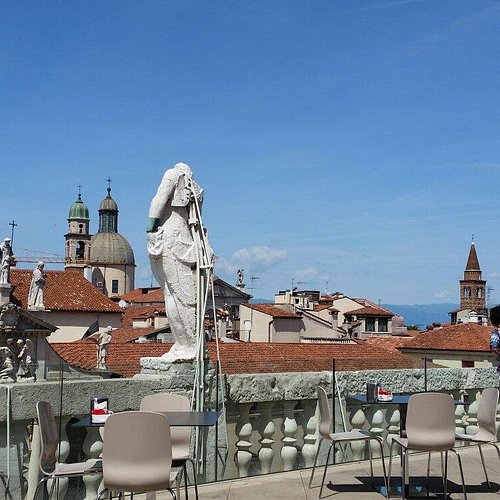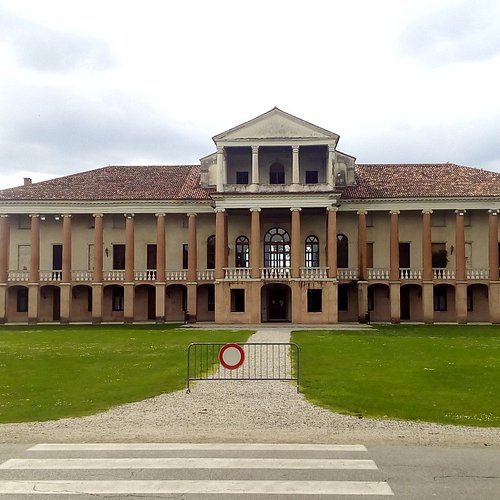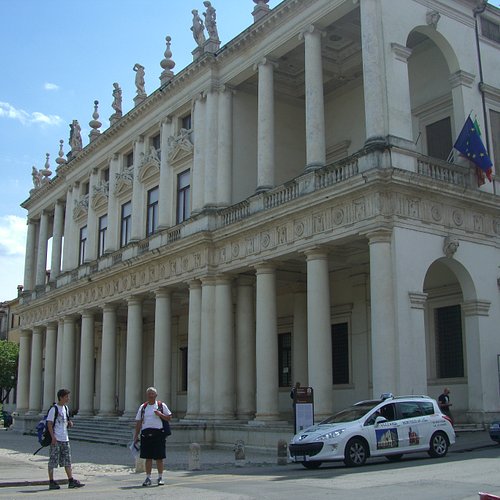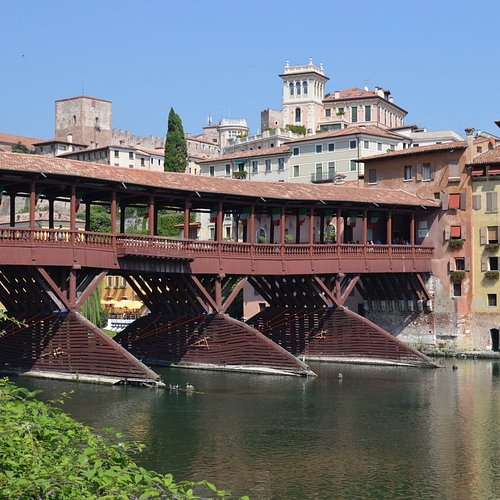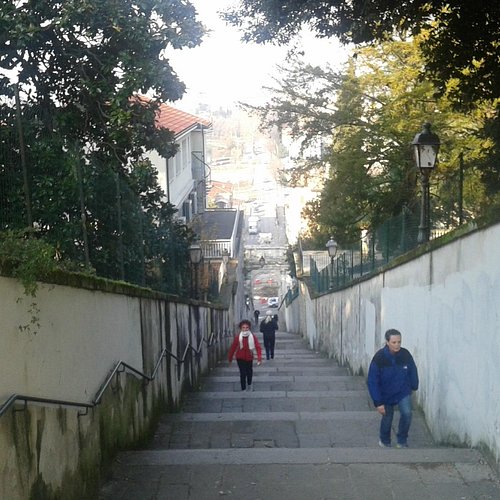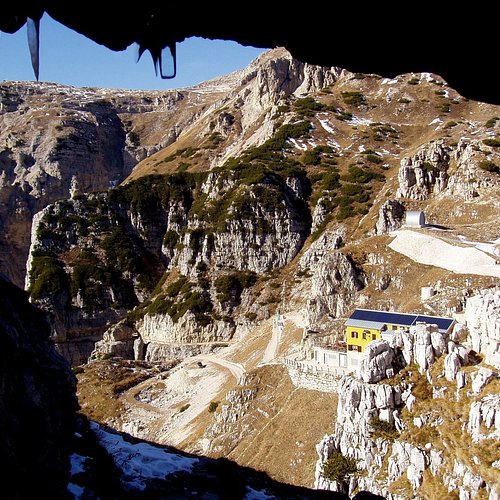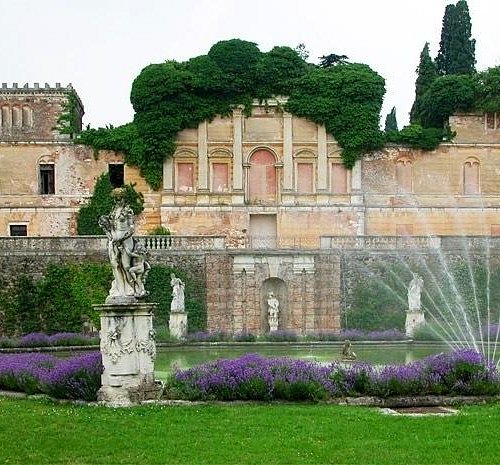The 10 Best Sights & Landmarks in Province of Vicenza, Veneto
The Province of Vicenza (Italian: Provincia di Vicenza) is a province in the Veneto region of northern Italy. Its capital city is Vicenza.
Restaurants in Province of Vicenza
1. Basilica Palladiana
Overall Ratings
4.5 based on 2,165 reviews
The Palladian Basilica is a public building facing onto the Piazza dei Signori. Its name is linked to Andrea Palladio, who redesigned it, adding the famous loggias with serliana openings in white marble to the existing Gothic building. The building on which Palladio worked was the Palazzo della Ragione, built in Gothic style in the mid-fifteenth century. The upper floor is entirely taken up by an enormous hall with no intermediate supports, where the Council of the Four Hundred met. The copper-lined, inverted ship’s-hull roof was inspired by that of the Palazzo della Ragione in Padua. The Gothic facade was originally clad with diamonds of red and straw yellow Verona marble, which are still visible behind Palladio’s addition. A loggia surrounding the building was commissioned after its completion, but continually delayed due to various structural difficulties and the nature of the ground beneath. At the beginning of the sixteenth century the double order of porticoes and loggias, though not complete, collapsed. The Council called on many leading architects of the time to resolve the difficult problem of its reconstruction. They included Jacopo Sansovino, Sebastiano Serlio and Giulio Romano. The project was awarded to Andrea Palladio (1508-80) in 1549, following a competition, and he worked on it for the rest of his life. It was completed posthumously in 1614. The reconstructed building was called a basilica by Palladio himself, who had been inspired by the model of the Roman basilica for civic use. The building has three independent exhibition spaces that are used to host architecture and art exhibitions of international renown.
Reviewed By peterbysea
A vast structure filling the piazza. The upper hall with the wooden roof of an upturned boats hull is amazing. The view from the external galleries is pleasent over the market place. Sadly in winter the upper roof area is closed for H&S reasons! Take the lift up!
2. Piazza dei Signori
Overall Ratings
4.5 based on 1,715 reviews
Reviewed By TBBTGrace - San Francisco, United States
Piazza dei Signori (Square of the Lords) is the main square of this little gem of a town, Vicenza. During the Roman Empire it was the center of markets and exchange of commercial business, as well as one the main strolling areas of the citizenship.
3. Villa Morosini Cappello
4. Palazzo Chiericati
Overall Ratings
4.5 based on 553 reviews
The Palazzo Chiericati has been the historic home of the Civic Museum since 1855 and now houses the city's collections of paintings, sculptures and applied arts from the thirteenth to the twentieth centuries. A masterpiece of Palladio's early maturity (1550), the building not only has decorations from that period but also holds important documents on Vicenza's art history. The Museum of Palazzo Chiericati reopened the Palladian wing on December 2013, after the restoration works. On the main floor, the visitor can enjoy the works of the sixteenth and seventeenth centuries, contemporary to the construction of the building. The attic hosts the Bequest of Marquis Giuseppe Roi: his personal collection of paintings, drawings and engravings from the fifteenth to the twentieth century, set in a charming display of house-museum. On the ground floor the visitor can admire, in a temporary exhibition, a selection of masterpieces of the collection not currently on display: Paolo Veneziano, Memling, Montagna, Fogolino, Sansovino, Tintoretto, Maffei and Pittoni. In the basement are located the works donated to the museum by the sculptor Nereo Quagliato.
Reviewed By christina_stilista - Perth, Australia
Very beautiful museum and Palazzo that is worth the visit. Beautiful collection of art in addition to the Palazzo. There is an antique toy exhibit in the basement that is EXCEPTIONAL. I have never seen better anywhere in the world. I suggest you include this Palazzo in your visit to the Teatro Olimpico.
5. Ponte degli Alpini
Overall Ratings
4.5 based on 2,178 reviews
This marvelous bridge made in wood, named Ponte Degli Alpini, is dated from 1209, although it was rebuilt some times along the centuries. It is also called Ponte Vecchio, and the view one can enjoy from it, over the Brenta river and facing the Alpes during the Winter, is simply great !
Reviewed By 674ligiaj - Florida, United States
It is being repaired but once it is finished it will be back to its glory. It really is very different from any other covered bridge I have seen.
6. Santuario della Madonna di Monte Berico
Overall Ratings
4.5 based on 743 reviews
Reviewed By larryrosen99 - Wayne, United States
The sanctuary is situated at the top of a hill overlooking Vicenza. It can be reached by car or on foot. It’s a 20-25 minute walk from the old city, up a fairly steep hill, with sidewalks on both sides on both sides of the road. Visitors are rewarded with panoramic views of the city with jagged mountain peaks in the distance. The sanctuary is white and is adjoined by a well-proportioned brick clock tower. This is a beautiful spot!
7. Sacrario Militare del Leiten
8. Road of 52 Tunnels
Overall Ratings
4.5 based on 896 reviews
Reviewed By ICooksey54 - Bridgwater, United Kingdom
This walk is a hidden gem. It forms part of the Cima Palon mountain and the infamous Pasubio World War 1 battlefield. Before undertaking this I would suggest reading a little about the events that took place here between 1916 and 1918 to understand the significance of what you will experience. The area consists of high Alpine Mts, approx 6000 feet / 2000ms above sea level and on the southern fringes of the higher mts of the Dolomites. Although you will see many Italians wandering around the area in trainers and shorts be aware that it is a remote high mt environment and that in August it can turn very challenging with low visibility, thunderstorms and snow. Without mountain awareness and some basic skills of map reading and mountain safety it might get very unpleasant. There are very steep drop offs the Galleries path and in the tunnels you definitely need to have a head torch or phone with good light to pass through. Equally on hot days you will need sun cream and plenty of water as the route and descent require you to probably do 16 -20k with 2000m of ascent and descent across limestone mts where there is no water. There is a cafe at the start abd a mountain hut with drinks, meals and beds at the end of the road but still 1 hour below the summit of the Cima Palon. No climbing experience is needed or special kit but the climb is steady and relentless and on stony mule pathway consisting or rocky limestone ledges or gravel. There are significant vertical drops off the southern side of the Gallerie route and the easiest descent by the Scrirubbi Road, an easy but long walk back to the start. It will be a six hour day for sure. Mt Biking on the Tunnel route is NOT allowed but there are plenty of alternatives around and given the fact that it is battlefield and a sacred site in Italian history (plus a number of fatalities from bikers falling from the route) I would recommend that this is respected. There is also a Via Ferrata which starts near the tunnel entrance and follows the crest of the mountain ridge to the Refugio. Up above the Refugio lies the trenches and battle scars of the conflict where the Italian First Army halted the attack of the Austrian Hungarians at the Italian Tooth in 1916. There is a small chapel and ossuary cemetery high on the stony mountain with the remains of 5000 dead of both sides plus small walled area which are full of the scars of war, boots, barbed wire, bullets and shells etc. This is not the manicured battlefields of France but genuine very moving landscape untouched since 1916. It gives an all together different experience. The tunnel route was built over 9 months by the Italians so they could get supplies to their soldiers on the frontline as their original supply route ( the Srcirubbi Road) was easily shelled from the Austrian frontline and could only be used in the dark and with great difficulty. Once you realise the significance of what you walk along and the efforts that went into sending men to their deaths, the whole experience becomes far more than a mountain walk It is an astonishing and moving piece of mountain engineering and history and worth the time and effort to get there. It is in a remote location SE of Rovereto off the Paso Pasubio. There is a small parking area free to use as you first arrive or you can follow the road up to the start of the 52 Tunnels where there are now 2 large car parks where you will need to pay to park. There is also a small cafe complex at the start of the walk. It is a long slow drive to get there and an early start is recommended. It is not suitable for large motorhome based transport. Enjoy
9. Villa Valmarana ai Nani
Overall Ratings
4.5 based on 701 reviews
Venetian villa with superb frescoes of the most important Venetian painters of 18th century: Giambattista and Giandomenico Tiepolo. Still owned and inhabited by the Valmarana family, who bought it back in 1720. Open to the public for visits 7 days a week and available for events such as weddings, conferences, gala dinners, photo shooting, business presentations, concerts, representations, etc
Reviewed By Clinor - Canterbury, United Kingdom
If you are in Vicenza, it is very well worth making the effort to get to the Villa ‘ai Nani’, which is a charming Villa in its own right and has interior frescoes by Gianbattista Tiepolo following his decoration of the grand staircase at the Wurzburg Residence, Germany) and his son Giandomenico. This is my third visit to the Villa, and each time I never fail to be enchanted by the light airy frescoes of the Villa Pavilion. All the frescoes of the Pavillion have a classical theme. In my view the most outstanding ones are in the entrance room but there are four further rooms each with a different narrative. In the room of Aeneas, there is a photograph of the Pavilion after the bombing of Vicenza in 1944. It is truly shocking. Some of the ceiling frescoes do not survive or only in part. It would be good to have more information available about the restoration; it must have been a real labour of love. We walked around the gardens before returning to the Foresteria where we had bought our tickets. There you can see a series of painted rooms, some of which were painted by the Tiepolo father and son. They make an interesting counterpoint to the more noble themes of the Pavilion.
10. Villa Trissino Marzotto
Overall Ratings
4.5 based on 31 reviews

